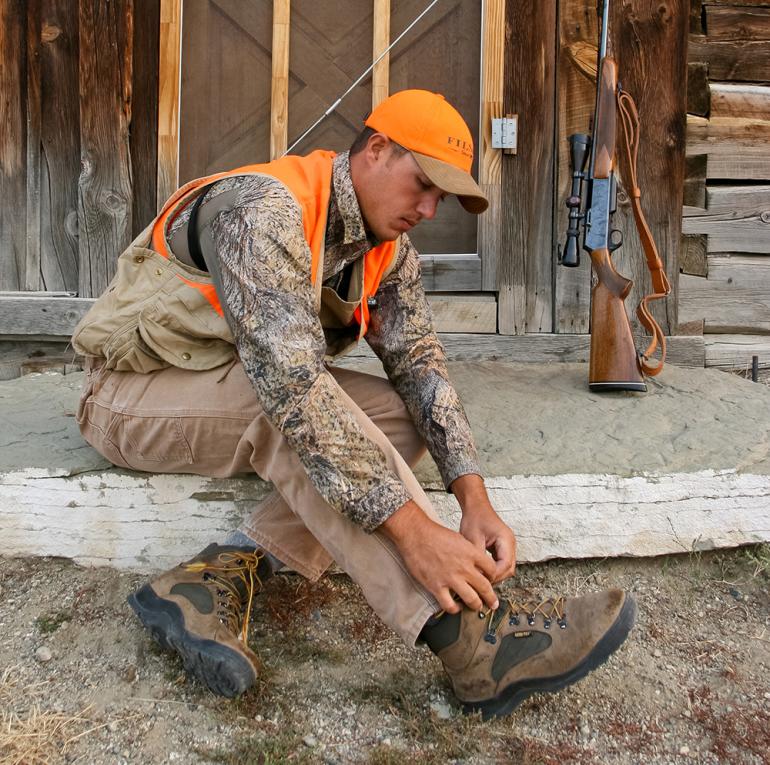Dynamic Duo
The fundamentals: choosing quality gear.
Hunting will take you to the grandest of places, in the most awesome of ways. It gives you reason to go somewhere absurd. Up a dark, deadfall-choked drainage; over a steep and rocky ridge you’d otherwise skirt; through that swampy forest you’ve always wondered about—it’s a primitive practice, raw in form and execution. And when gearing up for this exploratory pursuit, two imperatives stand out: a sturdy pack and a reliable pair of boots.
Big Game
It should go without saying, but your feet take care of the gruntwork, so take care of them. Your boots should mirror the type of terrain and weather you’ll run into. In the case of deer and elk, think stability. You’ll likely be in rough terrain, carrying plenty of weight, and you’ll probably encounter snow. Lean toward something taller, probably insulated, with aggressive tread.
As for packs, you’ll have to choose between a heavy-duty load-hauler and a smaller daypack, depending on how you hunt. If you bag an animal far from the truck, there’s work to be done. To minimize trips, I like to haul a hindquarter out with me right after a kill, so I roll with a larger pack. If you’re not venturing far, or you’ll have plenty of help nearby, a more compact model should suit you fine.
Upland Birds
When chasing grouse and pheasant, you can generally get away with a light hiker. But later in the year, you’ll want something that can handle snow. Maneuverability is important. Find a middle ground with a boot that has good ankle support and some insulation, but isn’t a sauna for your feet on those warm days in September.
Bird hunting doesn’t require as much gear or carry capacity, so your best bet is to find a vest—one that’s roomy enough for the essentials (water for you and the dog, ammo, a rain shell, a few birds) plus some comfort items. Again, as fall turns to winter, you’ll need to pack more stuff along. Make sure the vest allows for freedom of movement, so you can easily raise your shotgun. If you’re on a budget, a small daypack will suffice; just remember to keep a few extra shells in your pocket, for quick access.
Waterfowl
The commonality between fowl, as their name states, is water. And in general, the poorer the weather, the better the hunting. You’ll need a pair of boots that can get wet and stay warm in the cold. The bigger the better, especially if you’re planning on sitting in a duck blind in a snowstorm. Look for something waterproof with warm insulation, or at least something sized to hold a thick wool sock.
There are a couple things to keep in mind when it comes to carrying cargo on waterfowl hunts. First: are you bringing decoys, and if so, how many? Second: how far could the outing take you? If scouting out flocks and designing sets interests you, it’s worth investing in a cart to haul your loads. A bigger pack can work, such as the one you use for big game; it will just require more trips. However, if you’re simply the jump shootin’ kind, a bird vest or small daypack is all you need.
Archery
Bow hunters need to be sneaky and light on their feet. The season opens early, thus temps are warmer. Breathability is key. Find a pair of boots that have solid structure, somewhere in the six- to ten-inch range, but stays cool. Don’t sacrifice quality to save a few bucks. For elk hunting, you’ll be climbing hills, traversing ridges, and logging serious miles—err on the side of durability.
Archery packs differ little from big-game options; just make sure to get one somewhat color-coded to your environment. For packing meat, you can either get an external-frame pack, or one with the frame inside the body. The former is better for hauling bigger, heavier loads, but internal frames are generally lighter and more comfy for everyday use.













